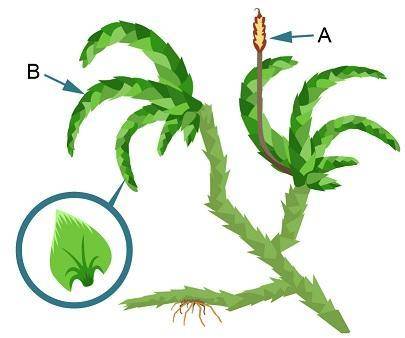
Biology, 10.03.2021 18:00, ochoachanna
A group of students was examining the moss Pterogonium gracile.
Diagram of a pterogonium gracile moss. A is a tall stalk. B is one of many branches, on which are diamond-shaped leaves.
The moss was found to have two structures:
A. A tall stalk structure that was present only in spring when the moss produced spores.
B. A brownish-green or brown branching structure that was present year-round.
The students produced several hypotheses about how the moss reproduced.
I. The branching structure is diploid and undergoes mitosis to produce the stalk.
II. The branching structure is haploid and undergoes meiosis to produce the stalk.
III. The stalk is haploid and undergoes mitosis to produce the branching structure.
IV. The stalk is diploid and undergoes meiosis to produce the branching structure.
When the students examined the moss, they found the stalk had 11 pairs of chromosomes and the branching structure had 11 chromosomes. Which hypothesis does this information support?
I
II
III
IV


Answers: 3
Other questions on the subject: Biology

Biology, 22.06.2019 00:30, azktanae5855
Ais a landform that is formed at the mouth of a river from the deposition of sediment carried by the river as the water flows.
Answers: 2

Biology, 22.06.2019 04:30, donald1255
Individuals do not compete directly for resources, but are prey for the same predator
Answers: 1

Biology, 22.06.2019 05:00, jxcxhxwxll
The chemical form of energy that is useable by the cell to do work
Answers: 2

Biology, 22.06.2019 13:30, student0724
Describe the change in phase and temperature as water moves from the oceans to the atmosphere and then returns to earth again as rain. a) evaporation : temperature increases; condensation : temperature decreases; precipitation (rain) : temperature decreases b) evaporation : temperature increases; condensation : temperature decreases; precipitation (rain) : temperature increases c) evaporation : temperature decreases; condensation : temperature decreases; precipitation (rain) : temperature decreases d) evaporation : temperature increases; condensation : temperature increases; precipitation (rain) : temperature decreases
Answers: 1
Do you know the correct answer?
A group of students was examining the moss Pterogonium gracile.
Diagram of a pterogonium gracile mo...
Questions in other subjects:

History, 05.07.2019 18:00


Mathematics, 05.07.2019 18:00



Chemistry, 05.07.2019 18:00

Mathematics, 05.07.2019 18:00

Biology, 05.07.2019 18:00

History, 05.07.2019 18:00

Spanish, 05.07.2019 18:00






